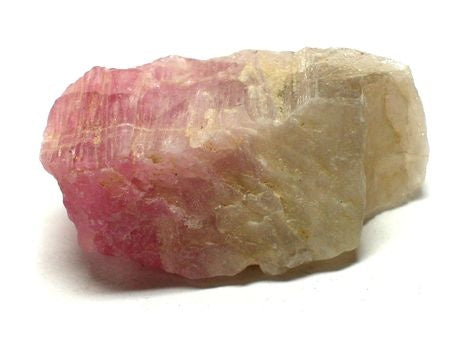Tourmaline, the Rainbow Gemstone
Rubies are red, emeralds are green. What the heck color is tourmaline?
 The tourmaline gemstone comes in many colors, often in the same stone. Its very name means mixed stone: "tura mali" from the Singhalese phrase "stone mixed with vibrant colors." Red, pink, peach, orange, yellow, brown, green, blue, purple, even black -- tourmaline is one of the most versatile gemstones, appearing in a variety of shades. Bi-color and tri-color stones are especially prized for jewelry. One of the more popular variations is the "watermelon tourmaline," with pink, green, and white color bands appearing naturally in the same stone.
The tourmaline gemstone comes in many colors, often in the same stone. Its very name means mixed stone: "tura mali" from the Singhalese phrase "stone mixed with vibrant colors." Red, pink, peach, orange, yellow, brown, green, blue, purple, even black -- tourmaline is one of the most versatile gemstones, appearing in a variety of shades. Bi-color and tri-color stones are especially prized for jewelry. One of the more popular variations is the "watermelon tourmaline," with pink, green, and white color bands appearing naturally in the same stone.
All gems have superstitions associated with them as to the meaning of the stone. Tourmaline, having many colors, has several meanings.
- Multicolor tourmaline promotes goodwill and self-assurance. It provides calmness, focus, balance, and protection.
- Green tourmaline, or verdelite, brings prosperity. It cleanses the spirit. It is also supposed to enhance strength, courage, stamina, and vitality.
- Blue tourmaline, or indicolite, aids in verbal difficulties, speech impediments, or throat problems. It is supposed to assist in meditation and communication.
- Red tourmaline, or rubellite, increases the zest for living and interaction with other people. Like rubies, it is associated with love.
- Yellow tourmaline is for self-esteem.
- Brown tourmaline is supposed to infuse the wearer with confidence and courage.
- Pink tourmaline promotes the healing of emotional pain and compassion. It is also supposed to reduce the tendency to fall, from babies learning to toddle to the elderly.
- Watermelon tourmaline is supposed to heal emotional pain and bring understanding.
- Black tourmaline, or schorl, is protection from negative energies. It is supposed to reduce fears, obsessions, panic, and neurosis and produces calmness. Some people consider it a talisman of protection, useful in purifying negative thoughts.
For tourmalines or other gemstones, contact us.

